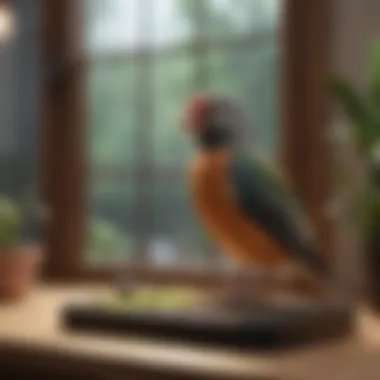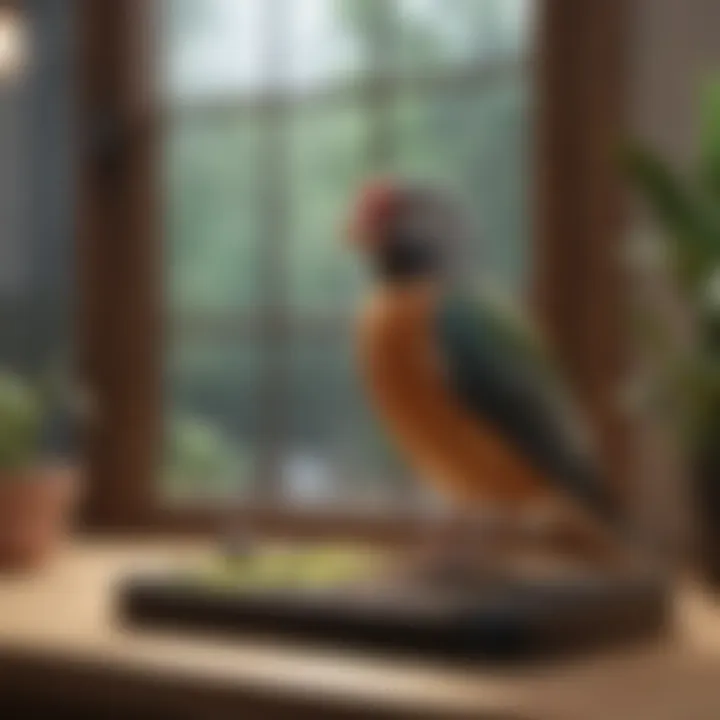Expert Strategies to Keep Your Pet Birds Comfortable


Intro
Maintaining an optimal temperature for pet birds is crucial for their overall health and well-being. Birds are particularly sensitive to temperature changes, which can lead to stress, illness, or even death. Recognizing the significance of temperature control within their environment cannot be overstated. This guide delves into various strategies, from environmental adjustments to dietary considerations, that enable bird owners to provide a stable and supportive habitat for their avian companions.
To ensure the comfort of pet birds, various approaches must be employed. Factors to consider include not only the immediate living environment but also daily routines, behavioral monitoring, and nutritional requirements. Let's explore these aspects in detail and understand how to effectively cater to the needs of our feathered friends.
Care Tips
Daily Care Routines
Daily routines play an essential role in ensuring the comfort of pet birds. Observing and maintaining a consistent schedule can help regulate the indoor climate effectively. Start each day with a thorough inspection of the cage and its surroundings. Ensure there is no direct sunlight streaming in or drafts entering the space. If the room temperature fluctuates, consider using curtains or blinds to help manage light and heat exposure.
Cage Setup and Maintenance
The cage setup is fundamental to creating a conducive environment. A well-structured cage not only offers safety but also promotes air circulation. Choose a cage that allows ample space for movement and is located in a stable environment where temperatures are generally consistent. Avoid placing the cage near heating or cooling vents, as this can increase temperature fluctuations.
Hygiene and Cleaning Practices
Hygiene is vital in combating factors that can lead to health issues. Regularly clean the cage, removing any waste, uneaten food, and potential contaminants that may affect air quality. Use bird-safe cleaning substances and ensure a thorough rinse before allowing birds back in the cage. A clean environment reduces stress and contributes to a healthier temperature regulation.
Seasonal Care Adjustments
As seasons change, so do the needs of pet birds. During warmer months, ensure there are shaded areas within the cage. Consider using fans or misting the environment to keep birds cool. In colder months, provide additional warmth through heat lamps or heating pads designed specifically for birds. Monitoring the ambient temperature closely during these transitions can mitigate stress and promote comfort.
"The well-being of pet birds is remarkably sensitive to temperature fluctuations."
Behavioral Insights
Understanding Bird Body Language
Birds communicate through body language. Understanding their signals can help identify if they are comfortable in their environment. Signs of discomfort or stress include ruffled feathers, excessive vocalization, or hiding behavior. By monitoring these behaviors, owners can promptly adjust the temperature or environment to maximize comfort.
Common Behavioral Issues and Solutions
Temperature-related issues can manifest in behavioral changes. For instance, if a bird is overly lethargic or agitated, they may be feeling too hot or cold. Being attuned to such changes is essential for effective care. Quick response measures may include adjusting the room temperature or providing new perches, so birds can find their comfort zones.
Positive Reinforcement Techniques
Positive reinforcement can encourage desirable behaviors in birds. For instance, rewarding calm behavior during temperature adjustments can create associations between temperature changes and positive experiences. This helps in reducing stress related to fluctuations, ultimately supporting optimal health and well-being.
Social Interaction Needs
Social interactions also play a vital role in a bird's well-being. Maintaining a stable temperature allows birds to engage more freely with their owners and surroundings. Allocate time for play and interaction to enhance their comfort and psychological health, which indirectly relates to the environmental stability they experience.
Nutrition Guides
Essential Diet Components
Dietary habits must align with temperature needs. A balanced diet is crucial for overall health. Ensure birds have access to fresh fruits, vegetables, and high-quality seeds or pellets. Nutritional intake influences their metabolism, helping them better regulate their body heat.
Safe and Toxic Foods
Be mindful of foods that can impact temperature regulation. Safe foods like apples, carrots, and leafy greens are excellent. However, avoid toxic ones like avocado, chocolate, and caffeine. Keeping a close eye on the diet can prevent adverse reactions that could affect health and comfort.
Supplements and Treats
Occasionally, offering supplements can address specific dietary gaps. Consult with a veterinarian to identify what may be necessary for your bird. Treats should complement a healthy diet while considering the current temperature and activity levels.
Feeding Strategies for Different Species
Different species have distinct dietary requirements. Understand the needs of your particular bird species and plan feeding strategies accordingly. Adapt the diet based on their activity level and temperature, ensuring it supports their overall well-being.
Wellness and Health
Routine Health Checkups
Regular vet checkups play a critical role in maintaining health. Schedule routine examinations to catch any potential health issues caused by temperature stress early. Awareness of temperature-related risks can streamline care and enhance your bird’s vitality.
Identifying Symptoms of Illness
Being alert to changes in behavior or physical appearance is vital. Signs like fluffed feathers, changes in appetite, or unusual droppings may indicate health issues. Identifying these signs quickly can help in taking preventive actions before conditions worsen.
Preventative Care and Vaccinations
Preventative measures, including immunizations, keep birds in good condition. Consult a veterinarian about recommended vaccines that suit your bird’s environment. Knowledge of their health risks supports effective temperature regulation and overall wellness.
Mental and Emotional Well-being
Comfortable temperatures contribute significantly to emotional stability in birds. Providing a supportive environment fosters a sense of security, safeguarding their emotional health. Emotional well-being is intrinsic to physical health, particularly in temperature-sensitive species.
Enriching Activities


Toys and Playtime Ideas
Engagement through toys and play stimulates birds both physically and mentally. Select interactive toys that challenge them, keeping them satisfied and content in their optimal temperature range. Rotate toys frequently to maintain their interest and prevent boredom.
Training and Tricks
Training provides excellent mental stimulation and strengthens the bond between owner and bird. Teach simple tricks or commands to keep their minds sharp. Positive reinforcement during training helps them feel comfortable, further supporting temperature regulation.
Outdoor Activities and Interaction
If safe, outdoor experiences expose birds to fresh air while keeping them engaged. Ensure temperatures are suitable before taking them outside. Monitor them closely to avoid overheating or freezing, ensuring they remain in their ideal comfort zone.
DIY Projects for Mental Stimulation
Creating DIY projects stimulates creativity for both the birds and their owners. Simple activities like making foraging toys from household items encourage exploration and mental engagement. Engaging birds in this way promotes comfort and satisfaction, essential for their overall well-being.
Preface to Avian Temperature Sensitivity
Understanding how temperature affects pet birds is crucial for any bird owner. Birds are ectothermic creatures, meaning their body temperature is significantly influenced by their environment. Small fluctuations in temperature can lead to serious health concerns. Therefore, maintaining an optimal temperature is not just a comfort issue; it directly impacts their overall well-being.
Understanding Physiological Responses
Birds have unique physiological mechanisms. Their metabolism can vary with temperature changes. When it's too hot or too cold, their body struggles to maintain a proper temperature. This struggle can lead to stress, impacting their health negatively. For example, overheating can cause heat stress. It can be fatal if not addressed promptly. Birds often show signs of discomfort like panting or losing appetite. Understanding these responses can help owners identify when their feathered friends are struggling. Proactively monitoring their environment is essential for preventing adverse reactions to temperature changes.
The Importance of a Stable Environment
A stable environment is vital for a pet bird's mental and physical health. Sudden changes in temperature can create stress, leading to behavioral issues. Adjustments to their habitat should be gradual to avoid shock. Features like consistent room temperature, even airflow, and shaded areas provide comfort. Additionally, a stable environment can promote better socialization and activity levels among birds. This stability allows the bird to thrive and express its natural behaviors without the burden of discomfort due to temperature variations. Owners must prioritize creating such conditions to enhance their pet's quality of life.
Signs of Heat Stress in Birds
Understanding the signs of heat stress in birds is crucial for ensuring their well-being. Birds are particularly vulnerable to temperature changes, and recognizing these signs can help pet owners take swift actions to prevent harm. Noticing indications of heat stress not only aids in providing immediate relief but also promotes long-term health and comfort for the bird. Hence, being aware of both behavioral and physical symptoms is essential for any bird owner.
Behavioral Indicators
Behavioral changes often serve as the first indicators of heat stress in birds. These subtle shifts in behavior can provide critical insights into their comfort levels. Common behavioral signs to watch for include:
- Decreased Activity: Birds experiencing heat stress may become lethargic. A previously active bird may sit still for long periods or show less interest in play.
- Panting: Birds may open their beaks and breathe rapidly in an effort to cool down. This is similar to how dogs pant and should not be ignored.
- Fluffed Feathers: When birds fluff their feathers, they may be trying to regulate temperature. However, if this occurs consistently, it might indicate discomfort.
- Seeking Cooler Areas: A stressed bird may aim to move towards cooler areas or shade, reflecting their innate survival instinct.
- Changes in Vocalization: A bird that's typically vocal may become silent or alter its calling patterns when experiencing discomfort.
Awareness of these behavioral cues can empower owners to adjust the environment accordingly and ensure that the bird feels secure and cool.
Physical Symptoms to Monitor
In addition to behavioral indicators, physical symptoms can provide clear evidence of heat stress in birds. Monitoring these symptoms is critical to ensuring your pet bird’s health. Common physical signs include:
- Rapid Heart Rate: An elevated heart rate can be a strong indicator of stress. Owners should check, if possible, the bird’s pulse to determine if it is higher than normal.
- Dehydration: Signs of dehydration may include sunken eyes, dry beak, and decreased urination. This can be a serious condition leading to health complications.
- Loss of Appetite: A bird that is significantly stressed may refuse food. This can lead to more severe health issues over time.
- Changes in Droppings: Observe the bird's droppings for changes in consistency or color. These can reflect stress and hydration levels.
- Weakness and Unresponsiveness: In severe cases, a bird may appear weak, unresponsive, or even collapse.
It is essential to remain vigilant and to act quickly if any of these symptoms are observed. Rapid intervention can prevent further complications.
Recognizing these physical symptoms allows pet owners to respond promptly. This might involve providing a cooler environment or consulting a veterinarian for further assessment. Knowledge of these symptoms enhances the quality of care provided to pet birds, ensuring they thrive even in warmer conditions.
Creating a Cool Environment
Creating a cool environment is fundamental to ensuring the well-being of pet birds. Birds, unlike many mammals, are highly sensitive to temperature extremes. Even slight increases in ambient temperature can lead to severe stress and health issues. Thus, establishing a comfortable habitat is not only advantageous but necessary for their health and longevity.
Optimal Room Temperature
Maintaining an optimal room temperature is essential for pet birds. Most birds thrive in a temperature range of 65°F to 80°F (18°C to 27°C). It’s crucial that their living space does not exceed this range, as higher temperatures can cause distress. After determining the best temperature range, you should obtain a reliable thermometer to monitor fluctuations. This allows immediate adjustments based on your birds' needs and current room conditions.
Air Circulation and Ventilation
Proper air circulation and ventilation are key components in creating a cool environment for birds. Stagnant air can lead to heat buildup. It is advisable to keep windows open when it is safe and appropriate to do so. Additionally, placing a fan in the room can help circulate the air effectively without creating drafts directly on the birds. Adequate ventilation reduces humidity levels and increases comfort for the birds.
Strategic Placement of Birdcages
The placement of birdcages within a home can significantly affect the temperature surrounding the birds. Avoid placing their cages near heat sources, such as radiators or direct sunlight, which can quickly elevate temperatures. Instead, opt for cooler areas with stable temperatures. Setting up the cages in shaded parts of the room allows the birds to enjoy a more comfortable atmosphere throughout the day.
Utilizing Natural Shade
Utilizing natural shade is another effective strategy for cooling your pet birds. Positioning cages near trees or large indoor plants can provide a significant temperature buffer.
Moreover, consider using blackout curtains or shades during the hotter months to block sunlight and reduce indoor temperatures. This simple adjustment can make a marked difference in the comfort levels of your birds during hotter parts of the day.
"Maintaining a stable and cool environment for your bird is critical to prevent heat stress and ensure their overall health."
Technological Aids for Temperature Control
Maintaining an optimal temperature for pet birds requires more than basic environmental adjustments. Technological aids can significantly enhance temperature control, allowing for a stable and comfortable habitat. With advancements in technology, bird owners have access to devices and systems that can efficiently regulate temperature, making it easier to safeguard their pet's well-being.
Thermostats and Temperature Regulators
Thermostats and temperature regulators are essential tools for monitoring and controlling the environment in which pet birds live. These devices can automatically adjust heating and cooling systems to maintain a consistent temperature. When choosing a thermostat, consider models that offer programmable settings. This feature allows you to set specific temperatures for different times of the day, accommodating variations in temperature throughout the day or night.


- Digital displays provide easy-to-read information.
- Smart thermostats can connect to mobile devices, facilitating remote monitoring.
- Set alerts for significant temperature changes, ensuring you can act quickly.
These devices help prevent dangerous fluctuations that can stress your birds. Therefore, investing in a high-quality thermostat is a crucial step toward creating a safe environment.
Fans and Air Conditioning Units
Fans and air conditioning units play a vital role in maintaining a cool environment for pet birds, especially during hot weather. A fan can improve air circulation while keeping the temperature comfortable. Ensure that the fan is not directed toward the bird directly, as this can cause discomfort. Instead, use it to circulate airflow.
Air conditioning units are particularly effective for larger spaces or environments prone to high heat. Considerations when using air conditioning include:
- Choosing units with adjustable temperature settings. This allows you to tailor conditions to your bird’s needs.
- Regular maintenance to ensure efficiency. Clean filters and check for any obstructions that could limit airflow.
Using these cooling methods in combination can create a harmonious environment where your bird can thrive.
Humidity Control Devices
Humidity control devices help manage moisture levels in the air, which is important for the health of pet birds. High humidity can lead to discomfort and health problems. Conversely, too little humidity can cause respiratory issues. Therefore, it is crucial to find the right balance.
Using a humidifier can help maintain optimal humidity levels, especially in dry climates. This device can add moisture to the air, making it more comfortable for your birds. However, be cautious of over-humidifying, which can lead to mold growth or respiratory problems.
- Humidity meters can help monitor levels accurately. These devices will alert you when humidity levels rise or fall beyond recommended ranges.
- Position devices away from the birdcage to avoid direct exposure, which may cause stress.
In summary, integrating technological aids into your bird’s environment can significantly improve their comfort and health. The key is to choose the right devices that suit your living space and avian companions.
Hydration Needs During Hot Weather
Maintaining proper hydration for pet birds during hot weather is crucial. Birds can become dehydrated quickly, and their health may deteriorate if they do not receive enough water. Adequate hydration supports their physiological functions and helps them manage the heat more effectively. Fresh, clean water is essential for all pet birds to thrive in warm conditions. It is not just about providing water; it is about ensuring it is readily available and safe for consumption under varying weather conditions.
Importance of Fresh Water
Every pet bird requires access to fresh water daily. Fresh water helps regulate their body temperature, supports digestion, and is vital for metabolic processes. In hot weather, birds’ need for water increases significantly. If their water supply is stale or contaminated, it can lead to serious health issues, including dehydration and digestive problems. Owners should regularly change the water to ensure cleanliness. It is also important to monitor how much water the birds consume to gauge their hydration status.
Encouraging Hydration
Types of Drinkers
When it comes to hydration, the type of drinker can impact how effectively birds will access water. There are several types of drinkers available on the market. Each has its unique advantages that can aid in keeping birds hydrated.
- Open Bowls:
- Gravity Feeders:
- Sipper Bottles:
- Easy to fill and clean.
- Birds can easily see and access the water.
- However, they are prone to contamination from waste and debris.
- These maintain a consistent water level.
- They reduce the frequency of refilling.
- Birds may not realize when the water is low, leading to potential dehydration if not monitored.
- These limit contamination, as the water is sealed.
- Birds can drink without spilling water, keeping the area clean.
- Some birds may take time to adapt to using these, which might lead to initial rejection.
Choosing the right type of drinker depends on the specific habits and behaviors of the bird species. Each option has pros and cons that can influence water consumption and overall health.
Utilizing Ice Cubes
During extreme heat, using ice cubes can be an effective strategy to promote hydration. Adding ice cubes to the bird’s water can help keep it cool, encouraging them to drink more frequently. This method not only cools the water but can create an engaging experience for the birds.
- Benefits of Ice Cubes:
- Considerations:
- Lowers water temperature, making it more appealing on hot days.
- Helps to keep water fresh longer, preventing bacterial growth.
- It is essential to monitor that ice does not completely freeze the water, as birds need liquid water to drink.
- Offering ice cubes directly can be interesting for birds, but it should always be done under supervision.
Dietary Adjustments for Temperature Regulation
Maintaining an optimal temperature for pet birds involves various strategies, and dietary adjustments play a critical role. Proper nutrition not only supports the overall health of birds but also helps them cope with thermal stress. Food choices can influence hydration, energy levels, and even metabolism, which are essential during temperature fluctuations. Ensuring that your bird receives the right nutrients can enhance its ability to regulate body temperature efficiently.
Incorporating Hydrating Foods
The inclusion of hydrating foods in a bird's diet can significantly mitigate the effects of heat stress. Fresh fruits and vegetables are excellent options that provide essential moisture along with valuable vitamins and minerals. Some notable examples include cucumbers, watermelon, and oranges. Each of these choices not only hydrates but also supplies antioxidants, which can help support overall health. Regularly incorporating these foods is beneficial, especially during warmer months when the risk of dehydration is heightened.
It's important to remember the variation of preference among different bird species. While some birds might relish juicy fruits, others may be less enthusiastic. Experimenting with a variety of options may be necessary to determine their favorites. Additionally, including leafy greens such as spinach or kale can improve hydration levels and enhance nutritional intake.
"Fruits and veggies contribute not just hydration, but also instill essential nutrients that keep a bird's health in check."
Monitoring Weight and Condition
Regular monitoring of weight and overall body condition is vital in ensuring that pet birds are thriving under varying temperature conditions. Weighing birds regularly helps track changes that might occur due to heat or inadequate nutrition. Sudden weight loss can indicate stress or dehydration, while sudden weight gain can signal an improper diet which might influence their ability to regulate body temperature.
Careful observation of a bird’s physical condition is equally important. Keeping an eye on feather quality and skin appears can reveal underlying issues. Healthy feathers help maintain body temperature, acting as insulation. If feathers lack luster or are falling out, it may indicate nutritional deficiencies or stress due to high temperatures.
Establishing a consistent feeding schedule also aids in observing trends in weight and condition. Understanding what is normal for your bird allows for quicker identification of potential issues. Always ensure fresh water is available alongside the food, as it complements the diet in managing the temperature.
In summary, dietary adjustments serve as a significant factor in ensuring the well-being of pet birds in fluctuating climates. By integrating hydrating foods and focusing on weight management, pet owners can help their avian companions adapt more effectively.
Behavioral Modifications to Encourage Coolness


In the context of maintaining an optimal temperature for pet birds, behavioral modifications can play a critical role in safeguarding their comfort and health. Birds have unique ways of coping with heat, and by influencing their behavior, owners can significantly mitigate the risks associated with temperature stress. These adaptations can also create a more serene environment, allowing birds to thrive actively while preventing overheating.
Encouraging Calmness and Rest
Encouraging calmness in pet birds is essential, especially during peak heat periods. Stress can raise their body temperature, leading to heat exhaustion. Here are suggestions to foster a peaceful atmosphere for your avian companions:
- Quiet Zones: Create areas in the home that are free of loud noises and rapid movements. Birds prefer tranquility, and this can help them relax and stay cool.
- Covering Cages: Using light, breathable covers on cages during the hottest part of the day can also shield them from direct sunlight.
- Routine Establishment: Maintaining a regular daily routine can give birds a sense of security, reducing stress levels.
These steps ensure that pet birds can rest adequately. Rest is crucial for their overall health, especially when dealing with heat.
Engaging Activities to Prevent Overheating
Engaging activities can keep birds active and distracted, reducing the likelihood that they will become overheated. When birds are mentally and physically stimulated, they are less likely to display behaviors that signal distress. Here are recommendations for activities to help minimize the temperature effects:
- Interactive Toys: Use puzzles or toys that require problem-solving. Activities that engage their brains can be refreshing and help prevent lethargy from heat.
- Shallow Water Dishes: Providing shallow dishes of cool water allows birds to splash and play, helping them to dissipate heat naturally.
- Gentle Mist Sprays: Lightly misting your birds on notably hot days can cool them down while providing hydration and stimulation.
Important Insight: Engaging activities not only help your birds avoid overheating but also contribute to their mental well-being. A stimulated bird is often a happier bird.
Combining these behavioral modifications can create an environment that promotes both calmness and activity, effectively addressing the heat challenges that pet birds face. Owners need to remain vigilant and ready to adapt these strategies as temperatures rise, ensuring their feathered friends remain safe and comfortable.
Seasonal Considerations
Understanding the seasonal changes is vital for maintaining an optimal temperature for pet birds. Each season brings unique challenges and necessitates specific strategies to ensure their well-being. Recognizing these variations can significantly enhance your pet birds' health and comfort.
Preparing for Summer Heat
Summer often presents the most significant threat regarding temperature regulation for pet birds. During this season, temperatures can rise steeply, posing risks such as dehydration and heat stress. Owners must take proactive steps to create a suitable environment.
Key Strategies for Summer Preparedness:
- Adjust Room Temperature: Aim to keep indoor environments between 70°F and 80°F. Avoid extremes, as temperatures above 85°F can be detrimental.
- Utilize Fans: Positioning fans strategically can enhance air circulation. This helps maintain a cooler ambient temperature around the bird's cage.
- Consider Air Conditioning: If the room temperature exceeds safe levels, ensure that air conditioning is used effectively. Maintain the temperature consistently to avoid sudden changes.
"Creating a cool and stable environment during the summer months is critical for the health and happiness of your pet birds."
Adjustments for Indoor Climate Control
Indoor climate control adjustments are essential throughout the year, but they are especially pertinent in the hot months. Birds are sensitive to temperature fluctuations and can react negatively to abrupt changes.
Strategies for Indoor Climate Control:
- Control Humidity: High humidity combined with heat can exacerbate stress in birds. Use dehumidifiers to maintain a comfortable level, ideally between 40% and 60%.
- Monitor Temperature Changes: Invest in thermometers that record both temperature and humidity levels. This allows for real-time adjustments to indoor conditions.
- Natural Ventilation: If possible, open windows during cooler parts of the day to allow fresh air in, while ensuring the birds are not exposed to direct sunlight or drafts.
By being attentive to seasonal considerations and making thoughtful adjustments to your bird's environment, you can foster a safe and comfortable space that meets their unique needs.
Observational Strategies for Bird Owners
Observational strategies play a vital role in ensuring the well-being of pet birds, especially in relation to temperature management. By observing their behavior and physical condition, owners can instinctively respond to changes that may indicate discomfort or health issues. A keen eye on their daily habits is essential in creating a stable environment that promotes optimal temperatures for these sensitive creatures.
Daily observations help in identifying any signs of heat stress or cold exposure. This proactive approach is beneficial for the birds’ health, assisting owners in recognizing problematic changes before they escalate into serious issues. Depending on the bird species, the indicators of discomfort can vary, thus understanding these nuances is crucial.
An organized method of keeping track of these observations can reinforce a bird owner's ability to provide effective care. Noting down any behavioral shifts or physical signs can inform adjustments in habitat, ensuring that environmental conditions remain supportive.
Daily Health Checks
Regular health checks are a cornerstone of any responsible pet ownership, particularly for pet birds. It is important to examine the feathers, eyes, and overall posture. Observing these aspects can indicate whether a bird is feeling too hot or too cold. A bird that is fluffed up may be trying to stay warm, whereas one that appears lethargic may be suffering from heat exhaustion. Key elements to focus on during these checks include:
- Feather condition: Well-groomed feathers suggest good health. Tattered or oily feathers are a signal for concern.
- Eye clarity: Clear eyes are signs of health; cloudy or watery eyes can indicate distress.
- Posture: An active, upright stance is normal. Slumped or apathetic posture is a red flag.
By conducting these checks consistently, owners can develop a strong understanding of their bird’s baseline health and behavior.
Behavior Monitoring Through Temperature Changes
Changes in a bird's behavior can provide insights into its current comfort level with temperature changes in its environment. Monitoring these behaviors is essential in ensuring that the bird remains within its optimal temperature range. Specific behaviors to watch for include:
- Increased vocalization: Birds may vocalize more if they are uncomfortable or stressed. This can indicate a problem in their environment.
- Changes in activity levels: A drop in activity can signal overheating or a need for cooler areas within the habitat.
- Seeking specific locations: Birds often move to different spots when they need to escape heat. Owners should take note of these movements and adjust the habitat accordingly.
Furthermore, recording these behaviors can help in establishing patterns over time. If a bird consistently reacts negatively during certain temperatures or at specific times of day, adjustments can be made to improve the living conditions.
Observing bird behaviors not only enhances the owner’s understanding but also promotes a proactive approach to maintaining consistent and comfortable temperature levels.
Finale
Maintaining an optimal temperature for pet birds is a crucial aspect of their overall health and well-being. This article examined various strategies that can be employed by bird owners to create a suitable environment for their avian companions. By understanding the physiological needs of birds, caretakers are better equipped to respond to their temperature sensitivities.
Summarizing Temperature Care Essentials
To summarize, the essential elements of temperature care include the following:
- Understanding the ideal temperature range: Most pet birds thrive in temperatures that range from 65°F to 80°F. It is important to measure the temperature regularly and ensure it stays within these limits.
- Implementing environmental modifications: Adjustments such as optimizing room temperature, ensuring proper air circulation, and strategically placing cages away from heat sources can create a more conducive habitat.
- Utilizing technology: Devices like air conditioning units and thermostats can help maintain a constant temperature, especially in extreme weather conditions.
- Providing sufficient hydration: Fresh water access is vital; encouraging hydration through engaging methods can prevent overheating.
- Modifying diets: Including hydrating foods and monitoring the bird's body condition can also aid in temperature regulation.
Encouraging Ongoing Vigilance
Bird owners must be vigilant and proactive in observing their flocks. Regular health checks and monitoring behavior for signs of temperature-related distress are crucial.
- Daily observations: Establish habits of checking for signs of stress or discomfort in the birds, especially during peak heat periods.
- Understanding behavioral changes: Watch for alterations in activity levels, as lethargy can indicate heat stress.
- Preparation for season changes: As seasons shift, ensure that necessary adjustments in temperature management protocols are implemented.
"Vigilance today leads to a healthier tomorrow for your pet birds."















